Oldsmobile’s W-43 V-8 Engine Was a “Killer” 32-Valve Prototype
One of the most notable participants in the 2024 Detroit Autorama is a special Oldsmobile 4-4-2 build packing a rare, experimental V-8 engine. To read about the twin brothers from Detroit responsible for this “Killer” project, click here. What follows is a technical and historical overview of the so-called W-43 prototype.
The mythical Dr. Olds was GM’s self-appointed innovation guru, with mass production, speedometers, front-wheel drive, turbocharging, a diesel V-8, automatic transmissions, anti-lock brakes, and chrome plating to his credit. So it should be no surprise that Olds engineers were pioneers in the movement to cram additional valves into their combustion chambers in pursuit of extra power. Behold, the W-43 prototype engine.
Oldsmobile’s special performance packages were generally coded with the letter W. In the late 1960s, the cause was volumetric efficiency: pumping extra fuel and air into—and exhaust out of—the engine to boost torque and horsepower. Work on the prototype W-43 V-8 shown here—a 455-cubic-inch muscle motor topped with heads sporting four valves per cylinder—began in earnest in the fall of 1967, though some of its technology had been in the engine lab for years.
One-upmanship was clearly at play in the W-43’s genesis. In the mid-1960s, Chrysler’s second-gen Hemi was the scourge of street and oval-track competition. Olds strived to trump Mopar by venturing beyond the Hemi V-8’s two valves per cylinder.
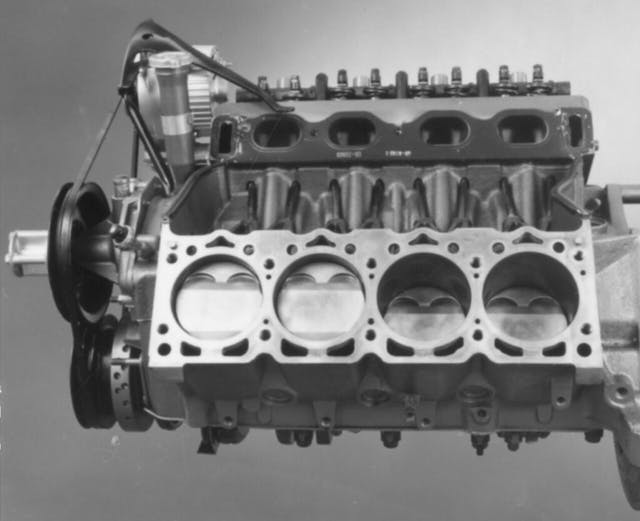
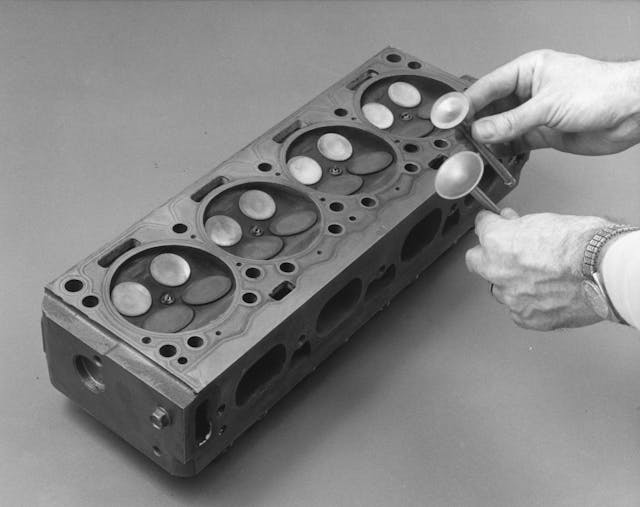
For the four-valve W-43 experiment, of which at least two examples are said to remain, a single chain-driven cam between the cylinder banks activates 16 pushrods. Each rod opens one pair of valves via rocker arms. To optimize this geometry, and to trim the mass of the pushrods in pursuit of super-high-rpm capability, the camshaft is elevated in the block exactly one inch in comparison with the 455 donor V-8.
Instead of Chrysler’s spherical combustion chambers, Oldsmobile used a simpler pent-roof arrangement which tipped valve faces toward the bore’s centerline. Spark plugs are centered to minimize flame travel, a configuration that necessitated sealing tubes in the valve covers. Pistons are domed.
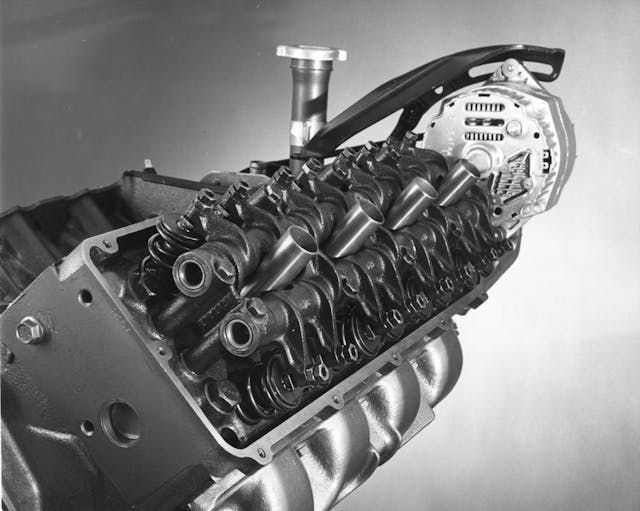
To expedite the development of these new cylinder heads, Olds engineers employed a flow bench that could accurately assess temporary mahogany models. Best results were achieved with 1.75-inch intakes and 1.375-inch exhausts. This yielded a 43 percent increase in valve curtain area—likely the reason that figure was selected for this engine’s code name (curtain area = valve circumference x lift).
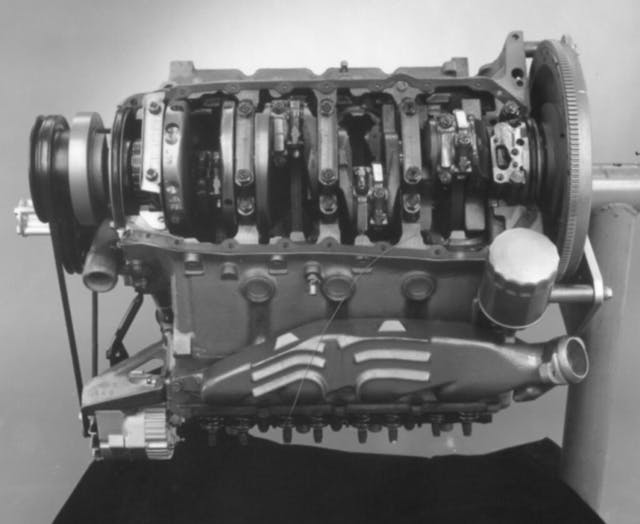
The 455-cubic-inch block, which continued 4.125-inch bore and 4.25-inch stroke dimensions, included one notable upgrade: To assure durability, new four-bolt main bearing caps were machined from forged steel.
Test results reported by Hot Rod magazine indicated a peak output of 440 horsepower at 4600 rpm with mild valve timing and a 4×2-barrel induction system. Those figures are modest by today’s standards likely because the engine was measured early in the development process.
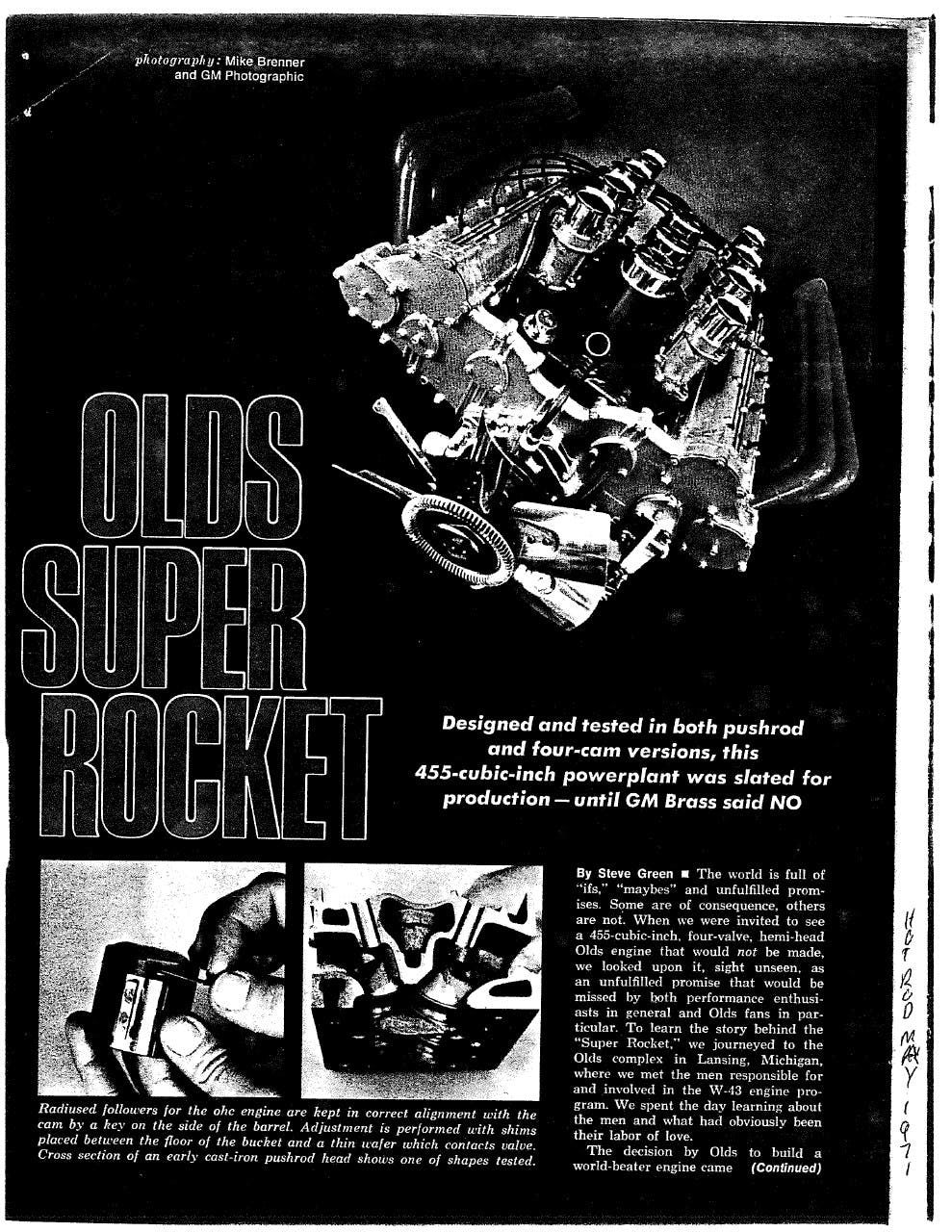
The late 1960s were Motown’s horsepower heyday. The Hurst/Olds specials introduced in 1968 are now highly prized collectibles. Olds engineers also built hot marine powerplants and twin-turbo V-8s intended for Can-Am racing. A spinoff design was coded OW-43. Experimental dual-overhead-cam, 32-valve V-8s were also constructed for dyno testing.
Unfortunately, doomsday lurked around the bend. In the early 1970s, the feds tightened emissions standards and OPEC triggered an energy crisis with an oil embargo. Exactly what Olds didn’t need was a V-8 which was heavier, bulkier, more expensive to manufacture, and thirstier than conventional designs.
Thus, the W-43 was shelved and never reached production status.
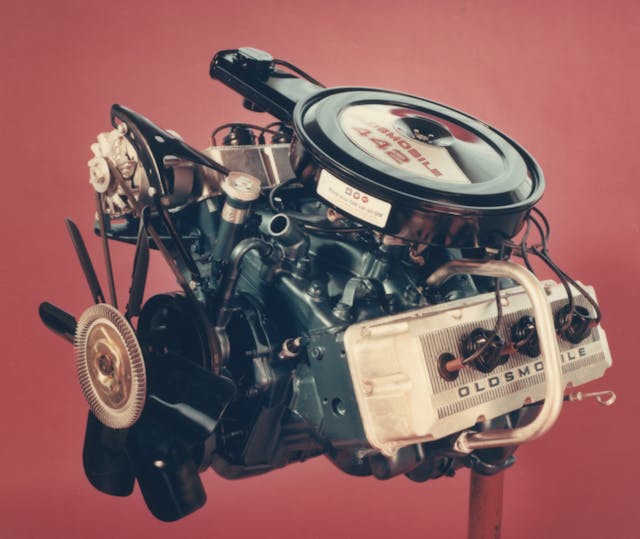
It wasn’t all wasted effort, however, as this fantastic footnote demonstrates: Oldsmobile’s 2.3-liter Quad-Four—produced from 1987 through 2002 and used to power millions of Chevys, Oldsmobiles, Pontiacs, and Buicks—furthered W-43 lessons from the ’60s with the addition of dual overhead cams. The Quad-Four was America’s first four-valve engine as well as the final powerplant wholly developed and manufactured by Oldsmobile.
That legacy also includes an entry in the speed records books. An Olds Aerotech streamliner, powered by a turbocharged Quad Four and driven by A.J. Foyt, topped 267 mph in an epic 1987 measured-mile run at the Fort Stockton Test Center in Texas, seizing the world land-speed record from Mercedes-Benz.
***
Check out the Hagerty Media homepage so you don’t miss a single story, or better yet, bookmark it. To get our best stories delivered right to your inbox, subscribe to our newsletters.
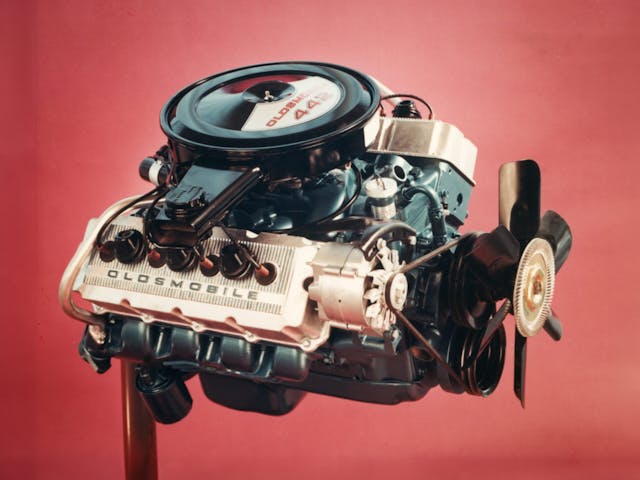


got a hunch it was the beneki brothers from warren,mi who had a chrome shop in warren(8mi),both had twin rods at autorama.
Today, with the DOHC design, and direct injection, VVT, twin turbos & intercooling, that 455 would be good for well over 1000 HP!!
When Ford came out with the 427 SOHC in 65 with roughly 650 hp in race form, Chrysler threatened to up the ante with a DOHC 426 that would reportedly approach 900. I don’t know if any were actually built or tested. Still it would have been interesting if the big 3 had continued developing these monsters.
There was one built, but was only turned by a 100 hp electric motor. I think broke some valve train parts and was forgot about. Was told a guy in Kansas ended up with it and then Mopar got it back for their museum. Don’t know how much of that is true, but came from a pretty good guy.
I remember an article in Automotive News about the Olds Quad 4. It included a mention and picture of a V 8 called the Quad 8. I don’t recall if it was an actual engine or a mock up. When the Cadillac North Star came out I wondered if it was the Quad 8 or at least developed from it. Then of course Oldsmobile got their own 4 liter version. Olds developed their IndyCar engines from this. They also developed the Olds Drag Race Engine with Warren. It was based off of the traditional Olds with the rotating assembly using big block Chevy dimensions. The evolution of this engine is still seeing success today. A J Foyt was working with C J Batten on an Olds V 8 for his Winston Cup Cutlass. It was the last GM stocker not using a small block Chevy based power plant to my knowledge. With the demise of Oldsmobile their competition engines got rebranded. Olds was swinging for the fences until the very end.
I saw the engine in the REO museum in 1984 on one of my trips.
This is so cool to see this magazine article on the W43. I’m now 59 years old and have always had much interest in performance engines out of Detroit. I remember the exact quote from reading this exact article from I believe a Hot Rod or Car Craft magazine back in the 70’s and the quote ” GM brass said NO! Now here probably 45 years later I see that article that left an impact on me of such an exotic engine that never was.
Recall reading in an article that Chrysler helped either Olds or Pontiac on a big multi-valve/possible DOHC engine around the mid sixties, wonder if it was this one.
It’s too bad this engine never saw production. A rear drive Oldsmobile Cutlass with this 32-Valve V8 would have been amazing.
Umm, the author states that the W43 “… was America’s first four-valve engine…”
Not so. Take a look at any two-stroke Detroit Diesel cylinder head. Yes, they are all exhaust valves, but there’s still four of them. And the greatest of all was the Miller/Offenhauser/Meyer-Drake four cylinder that dominated Indy and just about every sprint car race until it was legislated out of existence. Four valves, butts kicked, no waiting.
Duesenberg had a 32V inline 8 in 1928 – History Forgets.
All these posts are very misleading. I’ve seen many so far. An engine that uses a chain to turn the cams on an overhead cam engine does not use pushrods. It says so in your article. It says it uses followers. However, all the pictures are not of the same engine. The engine that says Oldsmobile on it is way different the the picture that says super rocket. Any motor head would know that and I’m surprised that this writer didn’t.
From what I read in the article about the DOHC heads were in development, not ever applied to this version of the experimental version but I might be wrong….
I was at Fort Stockton when the Aerotech record was set. We clocked at an unofficial 296 mph down the straight away on radar with the long tail on.